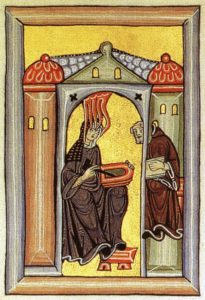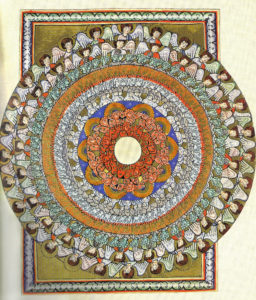Hildegard, known as the Sibyl of the Rhine, was a German Benedictine abbess, but she is most widely known as a composer, philosopher, and mystic. She was born into a family of minor nobility, but she was sickly as a child, and quickly offered as an oblate to a Benedictine monastery. It’s not clear just when she was “enclosed”: either it was at the age of eight; or at the age of eight she was entrusted to the are of Jutta, a daughter of Count Stephan II of Sponheim, and was subsequently enclosed at the age of 13, when Jutta herself was enclosed. Jutta taught Hildegard to read and write; Volmar, prior and father confessor for the nuns at Disibodenberg, where Hildegard resided, taught her psalmody, and probably also how to play the ten-stringed psaltery, a cross between a harp and a dulcimer.

Hildegard receiving a vision and dictating to her scribe and secretary, an illumination from her Liber Scivias. From Wikipedia.

“Vision of the angelic hierarchy”, illustration for Scivias, I.6, in the Rupertsberg manuscript. From Wikipedia.
Hildegard wrote a great deal of music. The most well-known is the Ordo Virtutum (“Play of the Virtues”), a morality play, and the first surviving musical drama not attached to a liturgy. The bulk of her liturgical songs were collected in a cycle called the Symphonia armoniae celestium revelationum. The songs are monophonic, that is, there is just the melodic line, but the melodies are often highly melismatic, and more soaring than the Gregorian chant of the day.
Hildegard also wrote extensively about medicine and the use of curative herbs. Her two major works in this area are Physica, which describes the scientific and medicinal properties of various plants, stones, fish, reptiles, and other animals; and Causae et Curae, which explores the human body, its connections to the rest of the natural world, and the causes and cures of various diseases. Hildegard was also a prolific letter writer, corresponding with popes (Eugene III and Anastasius IV), notable political figures (the German emperor Frederick I Barbarosssa), and religious figures (Saint Bernard of Clairvaux, and Elisabeth of Schönau, a fellow visionary).
Hildegard was one of the first persons to be the subject of the new Roman canonization process, but despite four attempts, she remained at the beatification stage. Nevertheless, she commanded a devout following, and at the end of the 16th century she was included in the Roman Martyrology. Benedict XVI extended the liturgical cult of Saint Hildegard to the entire Roman Catholic church, the equivalent of canonization, and shortly thereafter he named her a Doctor of the Church, making her only the fourth woman among 35 saints to hold that title. Her feast day is September 17th.


